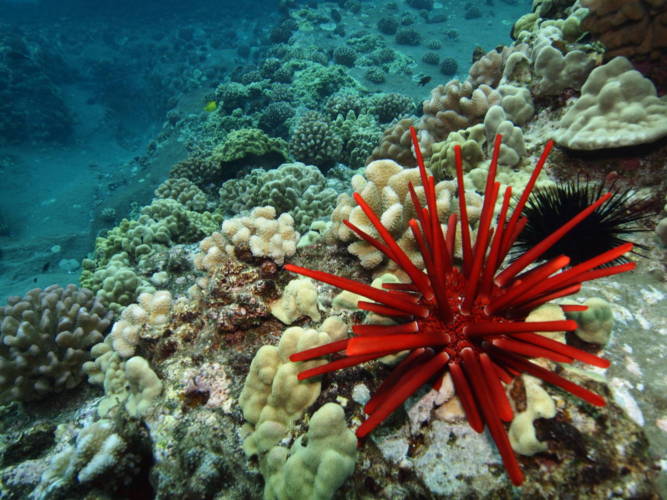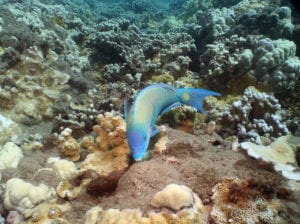Red Pencil Urchins & Parrot Fish
Creatures that Live Under the Sea
 Among the many things you will see on a snorkeling tour to Molokini Crater or elsewhere from Maui, the Red Pencil Urchin is a very easy to see “bright spot”!
Among the many things you will see on a snorkeling tour to Molokini Crater or elsewhere from Maui, the Red Pencil Urchin is a very easy to see “bright spot”!
They tend to remain in rocky sub-tidal habitats, just below the low tide line where the wave action is not extreme and to avoid sandy or muddy locations.
The Urchin has a body that is domed above and flat below, with it’s external skeleton, called the “test”, comprised of 10 fused, chalky plates covered with spines.
Every other section has holes through which the urchin’s “feet” are extended among the spines (called “tube feet”). These are actually long, thin, flexible tentacles with small suction cups.
It’s spines are connected to the “test” by ball joints that enable them to point in all directions. Also located among the spines and near the mouth are pincer-like structures called pedicellaria.
Red Sea Urchins maintain a diet of attached or drift seaweed and kelp. Their “teeth” are used to scrape algae off rocks. Urchins may hold onto kelp with their tube feet as they eat, or, if algae lands on top of one, may use a combination of its spines and tube feet to pass the food to its bottom located mouth.
Upon first glance, sea urchins appear incapable of moving. Sometimes, the most visible life sign is the spines, which can point in any direction. In most urchins, touch elicits a prompt reaction from the spines, which converge toward the touch point. Sea urchins have no visible eyes, legs, or means of propulsion, but can move freely over hard surfaces, using their adhesive tube feet and spines to help it move and to stay in place on the ocean floors.
 It’s hard to decide which of the colorful parrot fish’s many unique characteristics is most remarkable!
It’s hard to decide which of the colorful parrot fish’s many unique characteristics is most remarkable!
There’s its diet, which consists primarily of algae taken from pieces coral ripped from a reef with their tusk-like teeth that are fused together forming a beak, hence the “parrot fish”. The coral is ground down with their teeth in the fishes’ throats and made into sand. Much of the sand in the parrot fish’s range is actually the ground-up, undigested coral they excrete. There’s its gender, which they can change repeatedly throughout their lives, and their coloration and patterns, which are absolutely amazing and vary greatly, even between the males, females, and juveniles of the same species.
Finally, there are the pajamas. Every night, certain species of parrot fish envelope themselves in a transparent cocoon made of mucous secreted from an organ on their head. Scientists think the cocoon masks their scent, making them harder for nocturnal predators, like moray eels, to find.